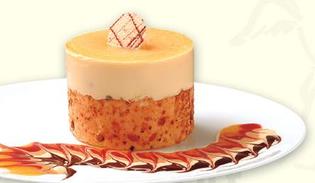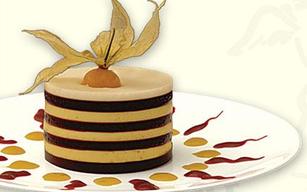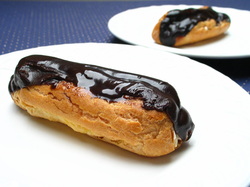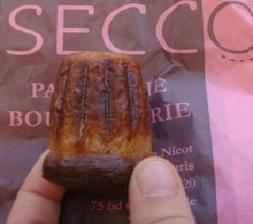Eating My Way Though Europe
Dessert
French pastries, like French women, are put together with precision.
-Anonymous
-Anonymous
French pastries are edible works of art. French pastries are unique creations made "using the best ingredients, fresh every day, and meant to be eaten immediately, if not sooner" (Gustafson, 2007, p. 31). To find a sweet treat in France, just head to a patisserie, which are shops devoted to pastries. To see evidence that French pastries look (almost) too pretty to eat , take a look at these beauriful photos from French parisseries.
Following are decriptions of a few classic French pastries:
Eclair:
An eclair is a simple pastry that is essentially an elongated cream puff. The "pate choux" dough becomes puffy and airy when baked, so that there is plenty of room for stuffing it with cream. The most common topping is chocolate sauce, but as you can see in the picture of eclairs at the top of the page, you can top them with sauces or icing in any flavor or color.
An eclair is a simple pastry that is essentially an elongated cream puff. The "pate choux" dough becomes puffy and airy when baked, so that there is plenty of room for stuffing it with cream. The most common topping is chocolate sauce, but as you can see in the picture of eclairs at the top of the page, you can top them with sauces or icing in any flavor or color.
Macaron:
The macaron is a sandwich cookie, but it's much fancier than an Oreo. The cookie is made with meringue, so it puffs up into a delicate, smooth shell. Half the fun of eating a macaron is cracking into that perfect dome with your teeth. Meringue is easy to add food coloring too, so French macarons are available in a rainbow of colors. The inside is typically filled with icing or jam. I liken the experience of eating a macaron to biting into a cloud - delicate, airy, and moist.
The macaron is a sandwich cookie, but it's much fancier than an Oreo. The cookie is made with meringue, so it puffs up into a delicate, smooth shell. Half the fun of eating a macaron is cracking into that perfect dome with your teeth. Meringue is easy to add food coloring too, so French macarons are available in a rainbow of colors. The inside is typically filled with icing or jam. I liken the experience of eating a macaron to biting into a cloud - delicate, airy, and moist.
Canele:
A canele is a small cake with a dark brown, caramelized exterior and a pale, dense, and moist interior. When I first bit into one, I was amazed at the contrast between the well-cooked outside and the practically raw inside. I later learned that the canele is technically more of a custard than a cake, which helps explain this contrast (Nash, 2010). A canele tastes of intensely rich vanilla with a hint of rum. Despite their small size, caneles are dense enough to satisfy any sweet tooth.
A canele is a small cake with a dark brown, caramelized exterior and a pale, dense, and moist interior. When I first bit into one, I was amazed at the contrast between the well-cooked outside and the practically raw inside. I later learned that the canele is technically more of a custard than a cake, which helps explain this contrast (Nash, 2010). A canele tastes of intensely rich vanilla with a hint of rum. Despite their small size, caneles are dense enough to satisfy any sweet tooth.
Petit Fours:
There is a large variety of petit fours, since they can be any bite-size French pastry. They're kind of like the dessert equivalent of hors d'oeuvre. However, the term is most commonly associated with tiny cakes, individually iced and decorated to look just like the larger version. Petit fours are perfect for when you're not very hungry, although I prefer to use petit fours as an excuse to sample several different desserts.
There is a large variety of petit fours, since they can be any bite-size French pastry. They're kind of like the dessert equivalent of hors d'oeuvre. However, the term is most commonly associated with tiny cakes, individually iced and decorated to look just like the larger version. Petit fours are perfect for when you're not very hungry, although I prefer to use petit fours as an excuse to sample several different desserts.
Gateau St. Honore:
This strange pastry is an over-the-top cake named for the patron saint of bakers and pastry makers. The base is made from puff pastry and airy choux dough (the same dough used for eclairs and cream puffs). The edge is then lined with cream-filled puffs dipped in hot caramel, which helps the puff stick to the base almost as if it were glue. The center is filled with cream or mousse, and often topped with fruit or additional cream puffs. Then the entire cake is decorated with more caramelized sugar, as you can see in the picture below. The one I made in culinary school had hundreds of wispy strings of caramelized sugar, which made the cake appear to be topped with golden hair.
This strange pastry is an over-the-top cake named for the patron saint of bakers and pastry makers. The base is made from puff pastry and airy choux dough (the same dough used for eclairs and cream puffs). The edge is then lined with cream-filled puffs dipped in hot caramel, which helps the puff stick to the base almost as if it were glue. The center is filled with cream or mousse, and often topped with fruit or additional cream puffs. Then the entire cake is decorated with more caramelized sugar, as you can see in the picture below. The one I made in culinary school had hundreds of wispy strings of caramelized sugar, which made the cake appear to be topped with golden hair.









